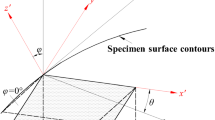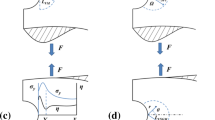Abstract
Fatigue performance of notched specimens of G20Mn5QT cast steel was investigated experimentally and analytically. Fatigue tests on a total number of 22 semi-circular notched specimens were conducted with the load ratios of − 1 and 0.1. Nominal stress-fatigue life relationship was obtained, and mean stress correction rules were verified for the notched specimens based on the test results. A new strain-based approach, strain field intensity (SNFI) method, was proposed, in which fatigue life of materials is predicted based on the weighted average strain in the fatigue damage region. The fatigue lives of the test specimens were predicted using three strain-based approaches, modified Neuber’s rule, equivalent strain energy density (ESED) method and the proposed SNFI method. The fatigue life prediction by the SNFI method was in very good agreement with the test results, which verified the rationality and applicability of the proposed SNFI method and also the adopted fatigue properties of G20Mn5QT cast steel. Both the modified Neuber’s rule and the ESED method gave conservative prediction of the fatigue life of the notched specimens. The necessity of the 3-dimensional fatigue damage region was also discussed for the proposed SNFI method.





















Similar content being viewed by others
Abbreviations
- b :
-
Fatigue strength exponent
- c :
-
Fatigue plastic exponent
- E :
-
Elastic modulus
- \(K^{\prime}\) :
-
Cyclic hardening coefficient
- K f :
-
Fatigue notch factor
- K t :
-
Theoretical stress concentration coefficient
- \(n^{\prime}\) :
-
Cyclic hardening exponent
- \(N_{f}^{{{\text{in}}}}\) :
-
Number of cycles corresponding to fatigue crack initiation
- N i :
-
Number of cycles at a certain time
- N f :
-
Number of cycles corresponding to fatigue fracture
- R :
-
Load ratio, minimum load divided by maximum load
- R ε :
-
Strain ratio, minimum strain divided by maximum strain
- r eff :
-
The effective radius
- V :
-
Volume of the fatigue damage region
- W s :
-
Nominal strain energy density
- W σ :
-
Local strain energy density
- ε :
-
Local strain
- ε 1 :
-
Maximum principal strain
- ε a :
-
Local strain amplitude
- \(\varepsilon^{\prime}_{f}\) :
-
Fatigue plastic coefficient
- ε nom :
-
Nominal strain on the net cross section
- \(\varepsilon_{{{\text{SNFI}}}}\) :
-
Strain field intensity
- \(\varepsilon_{{{\text{SNFI, }}a}}\) :
-
Strain field intensity amplitude
- Δε :
-
Local strain range
- Δεnom :
-
Nominal strain range on the net cross section
- \(\rho\) :
-
Notch radius
- σ :
-
Local stress
- \(\sigma^{\prime}_{f}\) :
-
Fatigue strength coefficient
- σ nom :
-
Nominal stress on the net cross section
- σ nom, a :
-
Nominal stress amplitude on the net cross section
- σ nom, m :
-
Nominal mean stress on the net cross section
- σ nom, max :
-
Maximum of nominal stress on the net cross section
- σ u :
-
Tensile strength
- σ y :
-
Yield strength
- Δσ :
-
Local stress range
- Δσnom :
-
Nominal stress range on the net cross section
- χ :
-
Relative strain gradient
- Ω :
-
Fatigue damage region
- φ :
-
Weight function
References
Luo P, Yao WX, Wang YY, Li P. A survey on fatigue life analysis approaches for metallic notched components under multi-axial loading. Proc Inst Mech Eng Part G J Aerosp Eng. 2019;233(10):3870–90.
Luo P, Yao WX, Li P. A notch critical plane approach of multiaxial fatigue life prediction for metallic notched specimens. Fatigue Fract Eng Mater Struct. 2019;42(4):854–70.
Yao WX. Stress field intensity approach for predicting fatigue life. Int J Fatigue. 1993;15(3):243–6.
Shang DG, Wang DK, Li M, Yao WX. Local stress–strain field intensity approach to fatigue life prediction under random cyclic loading. Int J Fatigue. 2001;23(10):903–10.
Yao WX, Ye B, Zheng LC. A verification of the assumption of anti-fatigue design. Int J Fatigue. 2001;23(3):271–7.
Adib H, Pluvinage G. Theoretical and numerical aspects of the volumetric approach for fatigue life prediction in notched components. Int J Fatigue. 2003;25(1):67–76.
Adib-Ramezani H, Jeong J, Pluvinage G. Structural integrity evaluation of X52 gas pipes subjected to external corrosion defects using the SINTAP procedure. Int J Press Vessels Pip. 2006;83(6):420–32.
Adib-Ramezani H, Jeong J. Advanced volumetric method for fatigue life prediction using stress gradient effects at notch roots. Comput Mater Sci. 2007;39(3):649–63.
Negru R, Șerban DA, Marșavina L, Magda A. Lifetime prediction in medium-cycle fatigue regime of notched specimens. Theor Appl Fract Mech. 2016;84:140–8.
Susmel L, Taylor D. An elasto-plastic reformulation of the theory of critical distances to estimate lifetime of notched components failing in the low/medium-cycle fatigue regime. J Eng Mater Technol Trans ASME. 2010;132(2):1–8.
Susmel L, Taylor D. On the use of the Theory of Critical Distances to predict static failures in ductile metallic materials containing different geometrical features. Eng Fract Mech. 2008;75(15):4410–21.
Susmel L, Taylor D. Estimating lifetime of notched components subjected to variable amplitude fatigue loading according to the elastoplastic theory of critical distances. J Eng Mater Technol Trans ASME. 2015;137(1):1–15.
Wang R, Liu H, Hu D, Li D, Mao J. Evaluation of notch size effect on LCF life of TA19 specimens based on the stress gradient modified critical distance method. Fatigue Fract Eng Mater Struct. 2018;41(8):1794–809.
Susmel L, Taylor D. The modified Wohler curve method applied along with the theory of critical distances to estimate finite life of notched components subjected to complex multiaxial loading paths. Fatigue Fract Eng Mater Struct. 2008;31(12):1047–64.
Luo PJ, Zhang QH, Bao Y, Zhou AX. Fatigue evaluation of rib-to-deck welded joint using averaged strain energy density method. Eng Struct. 2018;177:682–94.
Lazzarin P, Zambardi R. A finite-volume-energy based approach to predict the static and fatigue behavior of components with sharp V-shaped notches. Int J Fract. 2001;112(3):275–98.
Luo PJ, Zhang QH, Bao Y. Predicting weld root notch stress intensity factors for rib-to-deck welded joint under deck loading modes. Int J Fatigue. 2019;128:1–12.
Zhao YX. On the strain-based fatigue reliability analysis. Chin J Mech Eng. 2001;37(11):1–6 (in Chinese).
Manson SS. Fatigue: a complex subject - some simple approximations. Exp Mech. 1965;5(7):193–226.
Chen HT, Grondin GY, Driver RG. Characterization of fatigue properties of ASTM A709 high performance steel. J Constr Steel Res. 2007;63(6):838–48.
Topper T, Wetzel RM, Morrow J. Neuber’s rule applied to fatigue of notched specimens. J Mater. 1969;4(1):200–9.
Molski K, Glinka G. A method of elastic-plastic stress and strain calculation at a notch root. Mater Sci Eng. 1981;50(1):93–100.
Xu N, Chen JH. Energy method of local stress and strain fatigue. J Shandong Univ. 2006;36(1):15–8 (in Chinese).
Ye DY, Matsuoka S, Suzuki N, Maeda Y. Further investigation of Neuber’s rule and the equivalent strain energy density (ESED) method. Int J Fatigue. 2004;26(5):447–55.
Singh R, Chauhan S, Gope PC. Influence of notch radius and strain rate on the mechanical properties and fracture behavior of TIG-welded 6061 aluminum alloy. Arch Civ Mech Eng. 2016;16(3):513–23.
Han QH, Guo Q, Yin Y, Xing Y. Fatigue behaviour of G20Mn5QT cast steel and butt welds with Q345B steel. Int J Steel Struct. 2016;16(1):139–49.
Han QH, Guo Q, Yin Y, Xing Y. Effects of strain ratio on fatigue behavior of G20Mn5QT cast steel. Trans Tianjin Univ. 2016;22:302–7.
ASTM E606–92. Standard practice for strain-controlled fatigue testing. ASTM; 2004.
GB/T 15248-2008. The test method for axial loading constant-amplitude low-cycle fatigue of metallic materials. China; 2008 (in Chinese).
DIN EN 10293. Steel castings for general engineering uses. Germany; 2005.
GB/T 3075-2008. Metallic materials—fatigue testing—axial-force-controlled method. China; 2008 (in Chinese).
HB 5287–1996. Fatigue test method of metal materials under axial loading. China; 1996 (in Chinese).
Zhao SB. The anti-fatigue design manual, 2nd edn. Beijing: China Machine Press; 2015. pp. 113, 153–4, 171 (in Chinese).
Bhattacharya B, Ellingwood B. Continuum damage mechanics analysis of fatigue crack initiation. Int J Fatigue. 1998;20(9):631–9.
Shang DG, Wang DK. New prediction method of fatigue life under random loading. J Beijing Polytech Univ. 2001;27(4):433–6 (in Chinese).
Ye DY, Matsuoka S, Nagashima N, Suzuki N. The low-cycle fatigue, deformation and final fracture behaviour of an austenitic stainless steel. Mater Sci Eng A. 2006;415(1–2):104–17.
Luo YR, Wang QY, Liu YJ, Huang CX. Low cycle fatigue properties of steel structure materials Q235 and Q345. J Sichuan Univ. 2012;44(2):169–75 (in Chinese).
Han QH, Wang PP, Lu Y. Low-cycle multiaxial fatigue behavior and life prediction of Q235B steel welded material. Int J Fatigue. 2019;127:417–30.
Hawryluk M, Dolny A, Mroziński S. Low cycle fatigue studies of WCLV steel (1.2344) used for forging tools to work at higher temperatures. Arch Civ Mech Eng. 2018;18(2):465–78.
Navarro A. An unconditionally convergent iterative algorithm for the intersection of Neuber’s and Molski–Glinka’s rules with the Ramberg-Osgood stress-strain relationship. Theor Appl Fract Mech. 2014;69:53–62.
DS Simulia Corp. Abaqus/CAE User’s Guide. Dassault Systèmes (DS) Simulia Corp., RI, USA, 2014.
Acknowledgements
This work was supported by the National Natural Science Foundation of China (No. 51525803).
Author information
Authors and Affiliations
Corresponding author
Additional information
Publisher's Note
Springer Nature remains neutral with regard to jurisdictional claims in published maps and institutional affiliations.
Rights and permissions
About this article
Cite this article
Han, Q., Wang, Y., Yin, Y. et al. Fatigue tests on notched specimens of G20Mn5QT cast steel and life prediction by a new strain-based method. Archiv.Civ.Mech.Eng 20, 113 (2020). https://doi.org/10.1007/s43452-020-00114-1
Received:
Revised:
Accepted:
Published:
DOI: https://doi.org/10.1007/s43452-020-00114-1




